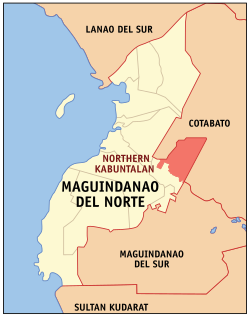Northern Kabuntalan اتار كبنتالن | |
|---|---|
| Municipality of Northern Kabuntalan | |
 Map of Maguindanao del Norte with Northern Kabuntalan highlighted | |
 | |
Location within the Philippines | |
| Coordinates: 7°12′06″N124°28′29″E / 7.201661°N 124.474736°E | |
| Country | |
| Region | |
| Province | Maguindanao del Norte |
| District | Lone district |
| Founded | December 30, 2006 |
| Barangays | 11 (see Barangays) |
| Government | |
| • Type | Sangguniang Bayan |
| • Mayor | Datu Umbra B. Dilangalen |
| • Vice Mayor | Datu Mohammad Shaffie C. Bayam |
| • Representative | Sittie Shahara "Dimple" I. Mastura |
| • Municipal Council | Members |
| • Electorate | 12,951 voters (2025) |
| Area | |
• Total | 106.77 km2 (41.22 sq mi) |
| Elevation | 10 m (30 ft) |
| Highest elevation | 38 m (125 ft) |
| Lowest elevation | 0 m (0 ft) |
| Population (2020 census) [3] | |
• Total | 26,277 |
| • Density | 250/km2 (640/sq mi) |
| • Households | 4,448 |
| Economy | |
| • Income class | 5th municipal income class |
| • Poverty incidence | 40.26 |
| • Revenue | ₱ 149.9 million (2022) |
| • Assets | ₱ 163 million (2022) |
| • Expenditure | ₱ 123 million (2022) |
| • Liabilities | ₱ 46.84 million (2022) |
| Service provider | |
| • Electricity | Maguindanao Electric Cooperative (MAGELCO) |
| Time zone | UTC+8 (PST) |
| ZIP code | 9606 |
| PSGC | |
| IDD : area code | +63 (0)64 |
| Native languages | Maguindanao Ilianen Tagalog |
Northern Kabuntalan, officially the Municipality of Northern Kabuntalan (Maguindanaon: Inged nu Utara Kabuntalan; Tagalog : Bayan ng Hilagang Kabuntalan), is a municipality in the province of Maguindanao del Norte, Philippines. According to the 2020 census, it has a population of 26,277 people. [3]
Contents
During the second regular session of the first legislative assembly of the Autonomous Region in Muslim Mindanao, the regional legislature created Northern Kabuntalan out of 11 barangays of Kabuntalan, by virtue of Muslim Mindanao Autonomy Act No. 206, [5] which was subsequently ratified in a plebiscite held on December 30, 2006. The town was part of the province of Shariff Kabunsuan until its nullification by the Supreme Court in July 2008.
The ARMM law creating the municipality provides that its administrative center shall be established in barangay Tumaguinting.



